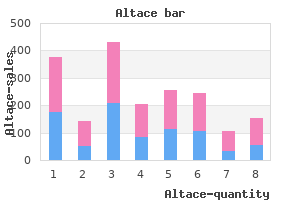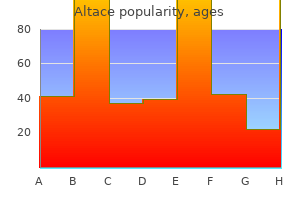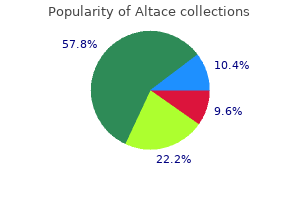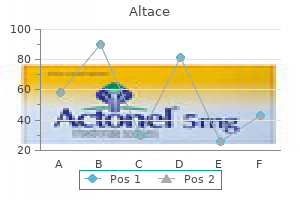Katarzyna Jadwiga Macura, M.D., Ph.D.
- Assistant Director ICTR Imaging Translational Program
- Professor of Radiology and Radiological Science

https://www.hopkinsmedicine.org/profiles/results/directory/profile/0015445/katarzyna-macura
Overweight arrhythmia specialist altace 1.25 mg amex, under weight blood pressure heart attack discount 1.25mg altace, and mortality: A prospective study of 48 blood pressure garlic order 5mg altace with visa, 287 men and women heart attack 5 hour energy order cheap altace on-line. Body mass index: Its relationship to basal metabolic rates and energy requirements. De novo lipogenesis, lipid kinetics, and whole-body lipid balances in humans after acute alcohol consumption. Basal metabolic rate, body composition and whole-body protein turnover in Indian men with differing nutritional status. No evidence for an ethnic influence on basal metabolism: An examination of data from India and Australia. Changes in adipose tissue volume and distribution during reproduction in Swedish women as assessed by magnetic resonance imaging. Changes in total body fat during the human repro ductive cycle as assessed by magnetic resonance imaging, body water dilution, and skinfold thickness: A comparison of methods. Effect of lactation on resting metabolic rate and on diet and work induced thermogenesis. No substantial reduction of the thermic effect of a meal during pregnancy in well-nourished Dutch women. Total, resting, and activity-related energy expenditures are similar in Caucasian and African-American children. Development of bioelectrical impedance analysis prediction equations for body composition with the use of a multicomponent model for use in epidemiologic surveys. Physical activity in relation to energy intake and body fat in 8 and 13-year-old children in Sweden. Effects of alcohol on energy metabolism and body weight regulation: Is alcohol a risk factor for obesity Age and menopause-associated variations in body composition and fat distribution in healthy women as mea sured by dual-energy x-ray absorptiometry. Energy requirements and dietary energy recommendations for children and adolescents 1 to 18 years old. Effect of a three-day inter ruption of exercise-training on resting metabolic rate and glucose-induced thermogenesis in training individuals. Energy expenditure in children pre dicted from heart rate and activity calibrated against respiration calorimetry. Fitness and energy expenditure after strength training in obese prepubertal girls. Effects of familial predisposition to obesity on energy expenditure in multiethnic prepubertal girls. The relationship between body weight and mortality: A quantitative analysis of combined information from existing studies. Maximal aerobic capacity in African-American and Caucasian prepubertal chil dren. The effect of environ mental temperature and humidity on 24 h energy expenditure in men. Synergistic effect of polymorphisms in uncoupling protein 1 and `3-adrenergic receptor genes on basal metabolic rate in obese Finns. Effect of an 18-wk weight-training program on energy expenditure and physical activity. Energy, substrate and protein metabolism in morbid obesity before, during and after massive weight loss. New equations for estimating body fat mass in pregnancy from body density or total body water. Body fat mass and basal metabolic rate in Dutch women before, during, and after pregnancy: A reappraisal of energy cost of pregnancy. Energy cost of physical activity throughout pregnancy and the first year post partum in Dutch women with sedentary lifestyles. Energy cost of lactation, and energy balances of well-nourished Dutch lactat ing women: Reappraisal of the extra energy requirements of lactation. Sea sonal variation in food intake, pattern of physical activity and change in body weight in a group of young adult Dutch women consuming self-selected diets. Resting metabolic rate and diet-induced thermogenesis in young and elderly subjects: Relation ship with body composition, fat distribution, and physical activity level. Reexamination of the relationship of rest ing metabolic rate to fat-free mass and to the metabolically active components of fat-free mass in humans. The etiology of obesity: Relative contribution of metabolic factors, diet, and physical activity. Do adaptive changes in metabolic rate favor weight regain in weight-reduced indi viduals Comparison of doubly labeled water with respirometry at low and high activity levels. Comparison of short term indirect calorimetry and doubly labeled water method for the assessment of energy expenditure in preterm infants. Determinants of energy expenditure and fuel utilization in man: Effects of body composition, age, sex, ethnicity and glucose tolerance in 916 subjects. A critical analysis of measured food energy intakes during infancy and early childhood in comparison with current inter national recommendations. Effects of a very-low-calorie diet on long-term glycemic control in obese Type 2 dia betic subjects. Pubertal African-American girls expend less energy at rest and during physical activity than Caucasian girls. Changes in plasma lipids and lipoproteins in overweight men during weight loss through dieting as compared with exercise. The effects on plasma lipoproteins of a prudent weight-reducing diet, with or without exercise, in overweight men and women. Spon taneous physical activity and obesity: Cross-sectional and longitudinal studies in Pima Indians. Comparison of high-calorie, low-nutrient-dense food consumption among obese and non obese adolescents. Physical activity, physical fitness, and all-cause mortality in women: Do women need to be active Validation of estimates of energy intake by weighed dietary record and diet history in children and adolescents. Database and quick methods of assessing typical dietary fiber intakes using data for 228 commonly consumed foods. The relation between energy intake derived from estimated diet records and intake determined to maintain body weight. The recommended quantity and quality of exercise for developing and maintaining fitness in healthy adults. Exercise Testing and Training of Apparently Healthy Individuals: A Handbook for Physicians. Muscular Work: A Metabolic Study with Special Refer ence to the Efficiency of the Human Body as a Machine. Respiratory gas-exchange ratios during graded exer cise in fed and fasted trained and untrained men. Physical activity and 10-year mortality from cardiovascular diseases and all causes: the Zutphen Elderly Study. Effects of exercise on appetite control: Loose coupling between energy expenditure and energy intake. Physical Activity, Fitness, and Health: International Proceedings and Consensus Statement. Glucose kinetics and exercise perfor mance during phases of the menstrual cycle: Effect of glucose ingestion. Exercise intensity: Effect on postexercise O2 uptake in trained and untrained women. The effect of exercise on clinical depression and depression resulting from mental illness: A meta-analysis. Twenty-four-hour profile of plasma glucose and glucoregulatory hormones during normal living condi tions in trained and untrained men.

The remaining neoplasms include serous and mucinous cystadenomas/cystadenocarcinomas arrhythmia nos buy cheap altace 1.25 mg line, solid pseudopapillary tumors blood pressure vertigo order 10 mg altace, and intraductal mucinous papillary adenomas/tumors blood pressure chart age wise discount 10mg altace with mastercard. Cystadenocarcinomas may be several times the size of typical ductal cancers and often arise in the body or tail of the pancreas blood pressure low range purchase generic altace online. They may become very large without invading adjacent viscera and do not generally cause significant pain or weight loss. The clinical presentation is usually quite subtle, with symptoms related primarily to the enlarging mass. There are no diagnostic laboratory findings, and definitive preoperative diagnosis is rare. An elderly patient with no history of pancreatitis is unlikely to have a pseudocyst, and a benign neoplasm is also less likely in this age group. Internal drainage is the treatment of choice for noninfected pancreatic pseudocysts (as opposed to external drainage which is the treatment of choice for infected pseudocysts) but is contraindicated if malignancy is suspected. Symptomatic herniation requires operative relocation of the stoma or mesh herniorrhaphy. They include irregularity of function, irritation of the skin due to leakage of enteric contents, or bleeding from the exposed mucosa following trauma. Prolapse occurs most frequently with transverse loop colostomies and is likely due to the use of the transverse loop to decompress distal colon obstructions. As the intestine decompresses, it retracts from the edge of the surrounding fascia, which allows prolapse or herniation of the mobile transverse colon. Optimal treatment of stomal prolapse is restoration of intestinal continuity or conversion to an end colostomy. Perforation of a stoma is usually because of careless instrumentation with an irrigation catheter. An acute abdominal series is composed of three x-rays (upright chest, upright abdomen, supine abdomen) and is useful in evaluating patients for bowel perforation or bowel obstruction. Patients with long-standing ulcer disease require a definitive acid-reducing procedure, except in high-risk situations and if the perforation is more than 24 hours old secondary to extensive peritoneal soilage. The choice of procedure is made by weighing the risk of recurrence against the incidence of undesirable side effects of the procedure, and considerable controversy persists about this issue. Antrectomy and truncal vagotomy offers a recurrence rate of 1%, but carries a 15% to 25% incidence of sequelae such as diarrhea, dumping syndrome, bloating, and gastric stasis. Highly selective vagotomy, if technically feasible, offers a 1% to 5% incidence of side effects but carries a recurrence rate of 10% to 13% in some series, although results are better when gastric and prepyloric ulcers are excluded. Pyloroplasty and truncal vagotomy carries intermediate rates of recurrence and side effects, but has the advantage of speed in the setting of very ill patients with acute perforation. Early dumping occurs within 20 to 30 minutes of eating and is attributed to the rapid influx of fluid with a high osmotic gradient into the small intestine from the gastric remnant. Late dumping syndrome occurs 2 to 3 hours after a meal; symptoms resemble those of hypoglycemic shock. Medical management consists of reassurance and dietary measures (avoidance of large amounts of sugars, frequent small meals, and separation of fluids and solids). Octreotide, a long-acting somatostatin analogue, can be used as well, but cost is a limiting factor. Surgery for intractable dumping consists of creation of an antiperistaltic limb of jejunum distal to the gastrojejunostomy. Initial resuscitation should be with isotonic crystalloids followed by transfusion of blood. Elevated prothrombin times should be corrected with fresh-frozen plasma, and although mild hypersplenism and thrombocytopenia are associated with portal hypertension, platelet transfusion is indicated only for platelet counts less than 50, 000/ L. Medical therapy consists of either octreotide or vasopressin to decrease splanchnic blood flow. Because of coronary vasoconstrictive effects, nitroglycerin is usually administered concomitantly with vasopressin. Balloon tamponade controls variceal hemorrhage immediately in more than 85% of patients. However, although balloon tamponade (Sengstaken-Blakemore tube) has reduced the mortality and morbidity from variceal hemorrhage in good-risk patients, an increased awareness of the associated complications (aspiration, asphyxiation, and ulceration at the tamponade site), as well as a rebleeding rate of 40%, have reduced its use. Balloon tamponade is indicated as a temporary measure when vasopressin or octreotide and sclerotherapy fail and other therapies are not immediately available (such as endoscopy with banding). In patients with well-compensated liver disease, portosystemic shunts can be used to prevent recurrent variceal bleeds. Portocaval, mesocaval, and splenorenal shunts are considered non selective shunts and are associated with the development or worsening of encephalopathy postoperatively. The distal splenorenal shunt is a selective shunt procedure and is associated with a lower rate of encephalopathy. However, in patients with Child C cirrhosis (poorly compensated liver disease), surgical shunting should be avoided because of increased operative mortality. Esophageal transection and reanastomosis, or the Sugiura procedure, are typically reserved for patients with splanchnic venous thrombosis who are not shunt candidates. The initial management of a gastric ulcer consists of antimicrobial therapy directed against H pylori. Indications for surgical intervention are hemorrhage, perforation, disease refractory to medical therapy, and inability to rule out a malignancy. Because approximately 5% of colorectal cancers are associated with resectable hepatic metastases, appropriate preoperative discussion should include obtaining permission for removal of synchronous peripheral hepatic lesions if they are found. Adequate local resection, either by wedge or by limited partial hepatectomy, may be carried out whenever no extrahepatic disease is found and the hepatic lesion is technically removable. Any option that leaves the symptomatic colon cancer (bleeding) would be unacceptable. This test samples the entire stomach and has sensitivity and specificity both greater than 95%. After ingestion the urea will be metabolized to ammonia and labeled bicarbonate if a H pylori infection is present. The labeled bicarbonate is excreted in the breath as labeled carbon dioxide, which can then be quantified. Serology is another noninvasive test to establish the diagnosis of H pylori infection. However, it cannot be used to assess eradication after therapy because antibody titers can remain high for over a year. Endoscopy with biopsy is necessary to provide a specimen for the rapid urease test, histologic evaluation, and culturing of gastric mucosa. The internal inguinal ring is an opening in the transversalis fascia for the passage of the spermatic cord; an indirect inguinal hernia, therefore, lies within the fibers of the cremaster muscle. A femoral hernia passes directly beneath the inguinal ligament at a point medial to the femoral vessels, and a direct inguinal hernia passes through a weakness in the floor of the inguinal canal medial to the inferior epigastric artery. Spigelian hernias, which are rare, protrude through an anatomic defect that can occur along the lateral border of the rectus muscle at its junction with the linea semilunaris. An interparietal hernia is one in which the hernia sac, instead of protruding in the usual fashion, makes its way between the fascial layers of the abdominal wall. These unusual hernias may be preperitoneal (between the peritoneum and transversalis fascia), interstitial (between muscle layers), or superficial (between the external oblique aponeurosis and the skin). When the clinical findings also include small-bowel obstruction in an elderly patient with history of gallstones and no prior abdominal surgery (a virgin abdomen), the diagnosis of gallstone ileus can be made with a high degree of certainty. In this condition, a large chronic gallstone mechanically erodes through the wall of the gallbladder into adjacent stomach or duodenum. When the gallstone arrives in the distal ileum, the caliber of the bowel no longer allows passage, and a small-bowel obstruction develops. The diseases suggested by the other response items (bleeding ulcer, peritoneal infection, pyloric outlet obstruction, pelvic neoplasm) are common in elderly patients, but each would probably present with symptoms other than those of small-bowel obstruction. Unlike the adenomatous polyps seen in familial polyposis, the lesions in this condition are hamartomas, which have no malignant potential. Duration of disease is very important; the risk of developing cancer is low in the first 10 years but thereafter rises about 4% per year.

Dietary fish oil reduces survival and impairs bacterial clearance in C3H/Hen mice challenged with Listeria monocytogenes blood pressure yahoo purchase altace with a visa. Gallai V arteria buccalis altace 2.5 mg on-line, Sarchielli P blood pressure ed discount altace 10mg otc, Trequattrini A prehypertension examples buy cheap altace 10 mg line, Franceschini M, Floridi A, Firenze C, Alberti A, Di Benedetto D, Stragliotto E. Blood fatty acid composition of pregnant and nonpregnant Korean women: Red cells may act as a reservoir of arachidonic acid and docosahexaenoic acid for utilization by the developing fetus. Effect of increasing breast milk docosahexaenoic acid on plasma and erythrocyte phospholipid fatty acids and neural indices of exclusively breast fed infants. Factors predictive of long-term coronary heart disease mortality among 10, 059 male Israeli civil servants and municipal employees. Essential fatty acid deficiency in total parenteral nutrition: Time course of development and suggestions for therapy. The effects of dietary t3 fatty acids on platelet composition and function in man: A prospective, controlled study. Brain docosahexaenoate accretion in fetal baboons: Bioequivalence of dietary linolenic and docosa hexaenoic acids. Biosynthesis of conjugated linoleic acid and its incorporation into meat and milk ruminants. Conjugated linoleic acid is synthesized endogenously in lactating cows by 69-desaturase. Newly recognized anticarcinogenic fatty acids: Identification and quantification in natural and processed cheeses. The predictability of risk factors with respect to incidence and mortality of myocardial infarction and total mortality. Effects of partially hydrogenated fish oil, partially hydrogenated soybean oil and butter on the susceptibility of low density lipoprotein to oxidative modifi cation in men. Clinical and chemical study of 428 infants fed on milk mixtures varying in kind and amount of fat. Essential function of linoleic acid esterified in acylglucosylceramide and acylceramide in maintaining the epidermal water permeability barrier. Evidence from feeding studies with oleate, linoleate, arachidonate, columbinate and linolenate. Effect of fish oil on the fatty acid composition of human milk and maternal and infant erythrocytes. Evaluation of an alternating-calorie diet with and without exer cise in the treatment of obesity. Deficiency of essential fatty acids and membrane fluidity during pregnancy and lactation. Dietary saturated fats and their food sources in relation to the risk of coronary heart disease in women. Dietary intake of linolenic acid and risk of fatal ischemic heart disease among women. Dietary fat and coronary heart disease: A comparison of approaches for adjusting for total energy intake and modeling repeated dietary measure ments. Correlation of isomeric fatty acids in human adipose tissue with clinical risk factors for cardiovascular disease. Effects of dietary 9-trans, 12-trans linoleate on arachidonic acid metabolism in rat platelets. Trans fatty acids in human milk are inversely associated with concentrations of essential all-cis n-6 and n-3 fatty acids and determine trans, but not n-6 and n-3, fatty acids in plasma lipids of breast-fed infants. Long-chain n-3 fatty acids in breast milk of Inuit women consuming traditional foods. Blood lipid docosahexaenoic and arachi donic acid in term gestation infants fed formulas with high docosahexaenoic acid, low eicosapentaenoic acid fish oil. Variability in the trans fatty acid content of foods within a food category: Implications for estimation of dietary trans fatty acid intakes. Absorption of individual fatty acids from long chain or medium chain triglycerides in very small infants. Effect of dietary linoleic/alpha-linolenic acid ratio on growth and visual function of term infants. Deficiencies of essential fatty acids, vitamin A and E and changes in plasma lipoproteins in patients with reduced fat absorption or intestinal failure. Effect of formula supplemented with docosahexaenoic acid and a-linolenic acid on fatty acid status and visual acuity in term infants. Dietary trans fatty acids: Effects on plasma lipids and lipoproteins of healthy men and women. Effects of marga rine compared with those of butter on blood lipid profiles related to cardio vascular disease risk factors in normolipemic adults fed controlled diets. Serum cholesterol and mortality in a Japanese-American population: the Honolulu Heart Program. Docosahexaenoic acid ingestion inhibits natural killer cell activity and production of inflammatory mediators in young healthy men. A stearic acid rich diet improves thrombogenic and atherogenic risk factor profiles in healthy males. Dietary n-3 polyunsaturated fatty acids and amelioration of cardiovascular disease: Possible mechanisms. Fatty acids and eicosanoids regulate gene expression through direct interactions with peroxisome proliferator-activated receptors and a. Fatty acid composition of breast milk from three racial groups from Penang, Malaysia. Adipose tissue trans fatty acids and breast cancer in the European Community Multicenter Study on Antioxidants, Myocardial Infarction, and Breast Cancer. Trans fatty acids may impair biosynthesis of long-chain poly unsaturates and growth in man. The role of fatty acid saturation on plasma lipids, lipoproteins, and apolipoproteins: I. Dietary saturated and trans fatty acids and cholesterol and 25-year mortality from coronary heart disease: the Seven Countries Study. Influence of dietary fat on the nutrient intake and growth of children from 1 to 5 y of age: the Special Turku Coronary Risk Factor Intervention Project. Maintenance of lower proportions of (n-6) eicosanoid precursors in phospholipids of human plasma in response to added dietary (n-3) fatty acids. Lapinleimu H, Viikari J, Jokinen E, Salo P, Routi T, Leino A, Ronnemaa R, Seppanen R, Valimaki I, Simell O. Effect of dietary enrichment with eicosapentaenoic and docosahexaenoic acids on in vitro neutrophil and monocyte leukotriene generation and neutrophil function. Energy intake required to main tain body weight is not affected by wide variation in diet composition. Lipid peroxidation in rat tissue slices: Effect of dietary vitamin E, corn oil-lard and mehaden oil. Assessment of trans-fatty acid intake with a food frequency questionnaire and validation with adipose tissue levels of trans-fatty acids. Effects of different forms of dietary hydrogenated fats on serum lipoprotein cholesterol levels. Platelet function, thromboxane formation and blood pressure control during supplementation of the Western diet with cod liver oil. A high-steric acid diet does not impair glucose tolerance and insulin sensitivity in healthy women. Randomised con trolled trial of a synthetic triglyceride milk formula for preterm infants. Lucas A, Stafford M, Morley R, Abbott R, Stephenson T, MacFadyen U, Elias-Jones A, Clements H. Efficacy and safety of long-chain polyunsaturated fatty acid supplementation of infant-formula milk: A randomised trial. Fatty acid composition of brain, retina, and erythrocytes in breast and formula-fed infants. A randomized trial of different ratios of linoleic to linolenic acid in the diet of term infants: Effects on visual function and growth. A critical appraisal of the role of dietary long-chain polyunsaturated fatty acids on neural indices of term infants: A randomized controlled trial. High saturated fat and low starch and fibre are associated with hyperinsulinemia in a non-diabetic population: the San Luis Valley Diabetes Study. Serum choles terol, blood pressure, and mortality: Implications from a cohort of 361, 662 men.

It has been shown over and over again that prehypertension blood pressure order altace overnight, despite the vaccination of a person against a particular illness pulse pressure guidelines altace 2.5mg cheap, the person may just develop that very illness he is supposed to be protected against blood pressure medication zestoretic order altace 2.5 mg otc, or even more so blood pressure quadriplegic purchase cheap altace online. The mere presence of specific antibodies cannot protect anyone against any illness, only the cellular immune system can. Although it is true that science knows how to bestow antibodies through vaccination, it mistakenly assumes that it is bestowing the immune strength that can only be developed through the experience of a particular illness. It is well known that several diseases, such as herpes outbreaks, may recur repeatedly despite high antibody levels. Whether or not antibodies are present, immunity to these infectious diseases can only be conferred by our cellular immune system. The theory that exposing the body to disease germs will trigger an immune response similar to the one generated during an actual disease experience is seriously flawed. As previously mentioned, the idea of vaccinating our bodies in order to protect them against possible infectious diseases came from the famous Louis Pasteur, who was considered to be the pioneer of immunization. Surprisingly, his diary entries contained especially negative results of experiments with vaccines whereas the publicized data had made the experiments look revolutionary. The published results of his most spectacular immunization experiments turned out to be a complete fraud. The authenticity of his research was never questioned until official statistical research revealed that immunization programs directly led to dramatic increases of those diseases they were supposed to eradicate. For example, diphtheria in France increased to an all-time high with the onset of compulsory immunization and immediately dropped again after the vaccine was withdrawn. The situation was not much different in Germany when compulsory immunization for diphtheria was introduced on a mass scale from 1925 to 1944. During this period the number of diphtheria victims increased from 40, 000 to 240, 000, with the incidence of infection being higher in immunized patients. Statistical data shows that most of these diseases were in rapid and continuous decline well before the introduction of immunization programs. The big epidemics began occurring when people from the rural areas moved into the big cities. The streets were used as garbage dumps, contaminating air and water, and becoming the source of infectious diseases. Only major cleanup of the congested cities, and improved sanitation, hygiene, and housing were able to halt the epidemics and lead to drastic improvements in individual and collective health. How to Acquire Immunity Naturally It seems that we humans tend to go from one extreme to the other. Now, the natural balance between immunity and presence of germs is becoming disrupted once again, but this time the cause may be the excessive emphasis on hygiene. Being over-hygienic can inhibit the natural development of immunity to disease-causing agents. The causative agent of poliomyelitis, for instance, is very common among the some native populations in the world; yet to them the virus is completely harmless. They rarely wash their hands before taking a meal and whatever else gets into their mouth with the food helps to build their natural resistance to harmful microorganisms. In the Western Hemisphere, poliomyelitis became a frightening disease only at the beginning of this century, with the onset of the high standard of hygienic living conditions. On the other hand, the increased measures of hygiene were necessary in the densely populated areas of big cities where there was little ventilation of air and inadequate sanitation. If necessary, they boosted their immune systems by injuring each other during rituals or by scarring their skin. So when you intentionally cut yourself, try to see it from a holistic perspective. You may have excessive protein in your blood or blood vessels and the bleeding may be just the thing to cause thinning of the blood and to prevent heart problems. This self-regulating mechanism is very powerful and keeps you healthier than any immunization program or mega-doses of vitamin and mineral supplements. This unspecified form of immunization may be necessary from time to time in order to maintain a strong and healthy intestinal 397 Timeless Secrets of Health and Rejuvenation flora (two thirds of our immune system is located in the intestinal tract). A recent study conducted at the Institute of Child Health at Bristol University, U. A few decades ago such diseases as asthma, eczema, and hay fever were almost nonexistent. Scientists now say that our obsession with the latest anti-germ potions and over-reliance on soap and water may explain why the Western world has been hit by a spate of viruses, immune-related diseases, and allergies. Rigorous hygiene drastically reduces the number of bacteria and other infectious agents that a developing immune system needs to battle to become stronger and more efficient. Allergies occur when the immune system labels harmless particles (house dust, pollen, etc. To fight them off, the body covers them with poison, which in turn results in inflammation, itching, swelling, and such symptoms as a runny nose. The Bristol study found, for example, that those children who washed their face and hands three or four times a day and bathed once a day suffered a significantly higher incidence of asthma than did the children who used soap and water much less frequently. Children from larger families are also less likely to suffer from asthma or hay fever. With many children living under one roof, minor infections are constantly brought into the household, which means that the immune system is kept busy and alert almost all the time. But if this normal response, that is, an infection, is undermined or prevented by artificial disinfectants or antibiotics, antibodies are no longer made and the immune system is weakened and begins to malfunction. By contrast, letting the infection take its full course strengthens the immune system, making it much more resilient to disease-causing germs afterwards. Many people who fail to employ the natural ways of strengthening the immune system are paranoid about becoming infected; for them, antibiotics and vaccines also remain ineffective. The vaccine against bacterial meningitis is made from the brains and heart of cows among other highly toxic components. By injecting such cocktails of foreign and destructive substances directly into the bloodstream, the human body stands little or no chance of neutralizing the poisons. The sudden appearance of a poison in the bloodstream is often met by a counterattack of the immune system that uses an entire arsenal of antibodies to prevent death from poisoning (allergic reaction). This allergic response can lead to a sudden, sometimes fatal, collapse known as anaphylactic shock response. Among the causes of anaphylactic shock are immunizations for 398 Timeless Secrets of Health and Rejuvenation diphtheria, tetanus, hepatitis B, and whooping cough. It is well known that children whose immune systems are already weak experience more serious complications than those whose constitution and immune system are much stronger. At this stage of development, a child has not yet acquired full natural immunity and has little ability to protect himself. Rheumatoid arthritis is an inflammatory disease of the joints, which had been thought to afflict only the elderly. More recently though, the crippling disease has spread among the young generation and measles and rubella inoculations have been identified as the cause. Researchers from the American Food and Drug Administration discovered that vaccinations, particularly the hepatitis B shot, could cause hair loss. They estimate that 50, 000 Americans suffer hair loss (alopecia) after immunization every year. The report was published by the Journal of the American Medical Association in 1997.

Gastroschisis: n the umbilical cord is attached to the abdominal wall to the left of the defect can blood pressure medication cause jaw pain discount altace master card. Lymphedema is often visible in the feet (A) and hands (B) at birth in girls with Turner syndrome arteria basilar order altace toronto. What are the most common syndromes associated with congenital diaphragmatic hernia A female infant is born with the following features: puffness of the dorsum of the hands and feet arteria ovarica cheap 10 mg altace overnight delivery, excessive skin at the nape of the neck with a low posterior hairline heart attack jack black widow 5mg altace amex, and a broad chest and widely spaced nipples. Single minor anomalies such as an isolated simian crease are common and not necessarily associ ated with an underlying genetic problem. However, as the number of minor anomalies increases, the likelihood of an underlying genetic diagnosis also increases. Susceptibility for some birth defects such as cleft lip and palate are multifactorial and caused by a combination of genetic and environmental factors. The fndings of intrauterine growth restriction or birth defects (or both) should warrant investigation into genetic, infectious, and teratogenic etiologies. Genetic testing can be performed on a blood sample and ideally should include testing for this panel of genes to maximize the sensitivity to make the diagnosis. Identifcation of a specifc mutation will provide some prognostic information about risk of arrhythmias, cardiomyopathy, and learning or intellectual disabilities. Genetic testing will also provide the family with important information about the risk of recurrence within the family. Noonan syndrome is autosomal dominantly inherited, but for cases diagnosed prenatally or neonatally, many result from de novo mutations. Can Noonan syndrome be diagnosed prenatally, and if so, what are the most common prenatal features Yes, the panel of 11 genes can be tested prenatally for Noonan syndrome using either a chorionic villus or amniocentesis sample. The most common ultrasound fndings are increased nuchal translu cency or cystic hygroma. Fetal growth restriction is the failure of a fetus to achieve its growth potential. In practice, measures of size relative to the population mean for gestational age and sex are used. The diagnosis of confned placental mosaicism postnatally is usually made retrospectively by follow-up studies on the infant or fetus, placenta, and membranes. Confned placental mosaicism may be associated with growth impairment in chromosomally normal fetuses. Overall, there appears to be a low risk of adverse pregnancy outcome with confned placental mosaicism. Can microdeletion syndromes such as DiGeorge syndrome be detected by a routine karyotype Whereas large deletions (greater than 5 megabases in size) are sometimes detectable on a karyotype, submicroscopic deletions cannot be visualized even on high-resolution chromosome banding. This technique has aided in the diagnosis of microdeletion syndromes that were once diffcult to detect because of their small size. The risk of aneuploidy increases with advanced maternal age; however, most aneuploid births are to mothers who are not of advanced maternal age. The majority of trisomies are a result of maternal meiotic errors; however, almost half of Klinefelter cases are caused by errors in paternal meiosis. Screening for Down syndrome with a combination of noninvasive ultrasound markers of nuchal translucency and maternal serum markers allows for greater than 95% sensitivity in detecting Down syndrome. Microdeletions are too small to be resolved by a karyotype and require fuorescence in situ hybridi zation. If the balanced translocation is inher ited, the phenotype in the child is predicted to be that of the balanced translocation carrier parent. If the translocation is de novo, there is an approximately 15% chance it will be associated with a phenotypic consequence such as a birth defect, cognitive impairment, or medical problem. The resolution of the chromosome microarray varies by laboratory, and higher and lower density arrays are available depending on the needs of the clinical situation. Patients with dysmorphic features, major congenital anomalies, developmental delay, intellectual disability, seizures, and failure to thrive should have this test. For a newborn baby with congenital heart disease and a diaphragmatic hernia, which test should you order frst, a karyotype or a chromosome microarray Chromosome microarray is now considered the frst line test to evaluate chromosomes. The only anomalies missed by a chromosome microarray are balanced translocations and low levels of mosa icism, but the prevalence of these types of chromosomal disorders is low. Consensus statement: chromosomal microarray is a frst-tier clinical diagnostic test for individuals with developmental disabilities or congenital anomalies. The geneticist cannot be reached, and you have to evaluate an intrauterine fetal demise. Anophthalmia is the medical term used to describe the absence of the globe and ocular tissue from the orbit. There are many causes of anophthalmia including single gene mutations, syndromes, chromosome abnormalities, and teratogenic exposures. This permits the termination of pregnancy at a signifcantly earlier date in the event of major chromosomal or genetic anomalies. What are the major characteristics of the three major chromosomal malformations: trisomy 21, trisomy 18, and trisomy 13 However, 50% to 55% of newborn infants with Down syndrome have a single transverse crease. Because Down syndrome occurs in 1 of every 800 live births, the chance that a newborn with a simian crease has Down syndrome is only 1 in 60. Intelligence deteriorates in adulthood, with clinical and pathologic fndings consistent with advanced Alzheimer disease. Autopsy results from the brains of deceased adults with Down syndrome reveal both neurofbrillary tangles and senile plaques, as found in Alzheimer disease. They tend toward mimicry and are noted usually to enjoy music, having a good sense of rhythm. However, 13% have serious emotional problems, and their coordination is usually poor. Why was the maternal age of 35 years at delivery chosen as the cutoff for recommending amniocentesis for chromosome analysis, and is this still relevant This may be related to the lengthy stage of meiotic arrest between oocyte development in the fetus and ovulation, which may occur as many as 40 years later (Table 11-2). With the advent of multiple noninvasive methods to screen for aneuploidies, invasive testing is driven more by results on the screening tests rather than maternal age alone. What percentage of babies with Down syndrome are born to women over the age of 35 The effects of prenatal diagnosis, population ageing, and changing fertility rates on the live birth prevalence of Down syndrome in New York State, 1983-1992. The chance of translocation Down syndrome is two to three times greater in children of younger mothers (6% to 8% of mothers younger than 30). One of three infants with translocation Down syndrome will have a parent with a Robertsonian translocation. Two thirds of the time, translocation Down syndrome occurs as a de novo event in the infant.
Altace 2.5mg without a prescription. A Closer Look at Omron M2 Basic Blood Pressure Monitor.

